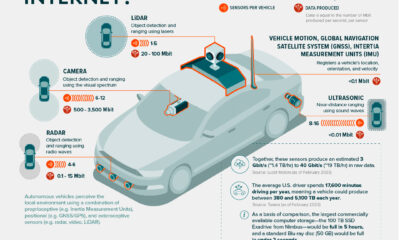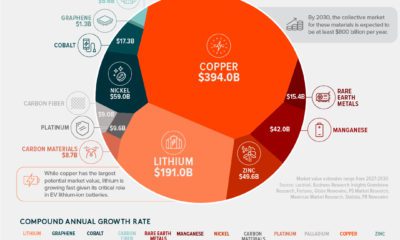In this graphic sponsored by Global X ETFs, we’ve visualized the largest corporate hacks of 2021, as measured by ransom size. The full list is also tabulated below. *Requested but not paid in full. Source: Microsoft (2021), CRN (2021) Continue reading below for details on some of these extraordinary hacks.
Energy: Colonial Pipeline Co.
The Colonial Pipeline ransomware attack was the largest ever cyberattack on an American oil infrastructure target. On May 7, hackers took down the company’s billing system and threatened to release stolen data if a ransom was not paid. During negotiations, the company halted its pipelines, resulting in gas shortages across the Southeastern United States. It’s been reported that Colonial Pipeline promptly paid a ransom of $4.4 million in bitcoin (based on prices at the time). The FBI managed to retrieve some of these bitcoins, but their exact method was not revealed.
Technology: Accenture
Accenture, one of the world’s largest IT consultants, fell victim to a ransomware attack in August of 2021. While this may seem ironic, it further proves that any business, regardless of industry, can be susceptible to hackers. The hack was traced back to LockBit, which claims to have stolen several terabytes of data from Accenture’s servers. A $50 million ransom was demanded, though it’s unknown whether the company actually made any payments.
Automotive: Kia Motors
Kia’s American business fell victim to a ransomware attack in February by a group called DoppelPaymer. Hackers threatened to release stolen data within 2 to 3 weeks if a ransom of $20 million (in bitcoin) was not paid. This hack affected various systems including the Kia Owner Portal, Kia Connect (a mobile app for Kia owners), and internal programs used by dealerships. This also prevented buyers from picking up their new cars. Kia denied it was hacked, but the timing of the ransom note and Kia’s service outages was suspicious. According to the FBI, DoppelPaymer has been responsible for numerous attacks since 2020. Victims include U.S. police departments, community colleges, and even a hospital in Germany.
Food: JBS
JBS, one of the world’s largest meat processing companies, experienced disruptions at its North American facilities in May. Shortly after, the company confirmed it had paid hackers a ransom of $11 million in bitcoin. This attack, along with the Colonial Pipeline hack, represents an alarming trend of critical industries being targeted. For context, JBS claims it has an annual IT budget of over $200 million, and employs over 850 IT personnel globally. The group responsible for this attack is known as REvil, a now defunct hacker group based in Russia.
Increased Spending on the Menu
The rising frequency and sophistication of corporate hacks is a major threat to the world. In fact, recent research from PricewaterhouseCoopers has highlighted that 69% of businesses predict a rise in future cybersecurity spending. The Global X Cybersecurity ETF is a passively managed solution that can be used to gain exposure to the rising adoption of cybersecurity technologies. Click the link to learn more. on Today’s connected cars come stocked with as many as 200 onboard sensors, tracking everything from engine temperature to seatbelt status. And all those sensors create reams of data, which will increase exponentially as the autonomous driving revolution gathers pace. With carmakers planning on uploading 50-70% of that data, this has serious implications for policymakers, manufacturers, and local network infrastructure. In this visualization from our sponsor Global X ETFs, we ask the question: will connected cars break the internet?
Data is a Plural Noun
Just how much data could it possibly be? There are lots of estimates out there, from as much as 450 TB per day for robotaxis, to as little as 0.383 TB per hour for a minimally connected car. This visualization adds up the outputs from sensors found in a typical connected car of the future, with at least some self-driving capabilities. The focus is on the kinds of sensors that an automated vehicle might use, because these are the data hogs. Sensors like the one that turns on your check-oil-light probably doesn’t produce that much data. But a 4K camera at 30 frames a second, on the other hand, produces 5.4 TB per hour. All together, you could have somewhere between 1.4 TB and 19 TB per hour. Given that U.S. drivers spend 17,600 minutes driving per year, a vehicle could produce between 380 and 5,100 TB every year. To put that upper range into perspective, the largest commercially available computer storage—the 100 TB SSD Exadrive from Nimbus—would be full in 5 hours. A standard Blu-ray disc (50 GB) would be full in under 2 seconds.
Lag is a Drag
The problem is twofold. In the first place, the internet is better at downloading than uploading. And this makes sense when you think about it. How often are you uploading a video, versus downloading or streaming one? Average global mobile download speeds were 30.78 MB/s in July 2022, against 8.55 MB/s for uploads. Fixed broadband is much higher of course, but no one is suggesting that you connect really, really long network cables to moving vehicles.
Ultimately, there isn’t enough bandwidth to go around. Consider the types of data traffic that a connected car could produce:
Vehicle-to-vehicle (V2V) Vehicle-to-grid (V2G) Vehicles-to-people (V2P) Vehicles-to-infrastructure (V2I) Vehicles-to-everything (V2E)
The network just won’t be able to handle it.
Moreover, lag needs to be relatively non-existent for roads to be safe. If a traffic camera detects that another car has run a red light and is about to t-bone you, that message needs to get to you right now, not in a few seconds.
Full to the Gunwales
The second problem is storage. Just where is all this data supposed to go? In 2021, total global data storage capacity was 8 zettabytes (ZB) and is set to double to 16 ZB by 2025.
One study predicted that connected cars could be producing up to 10 exabytes per month, a thousand-fold increase over current data volumes.
At that rate, 8 ZB will be full in 2.2 years, which seems like a long time until you consider that we still need a place to put the rest of our data too.
At the Bleeding Edge
Fortunately, not all of that data needs to be uploaded. As already noted, automakers are only interested in uploading some of that. Also, privacy legislation in some jurisdictions may not allow highly personal data, like a car’s exact location, to be shared with manufacturers.
Uploading could also move to off-peak hours to even out demand on network infrastructure. Plug in your EV at the end of the day to charge, and upload data in the evening, when network traffic is down. This would be good for maintenance logs, but less useful for the kind of real-time data discussed above.
For that, Edge Computing could hold the answer. The Automotive Edge Computing Consortium has a plan for a next generation network based on distributed computing on localized networks. Storage and computing resources stay closer to the data source—the connected car—to improve response times and reduce bandwidth loads.
Invest in the Future of Road Transport
By 2030, 95% of new vehicles sold will be connected vehicles, up from 50% today, and companies are racing to meet the challenge, creating investing opportunities.
Learn more about the Global X Autonomous & Electric Vehicles ETF (DRIV). It provides exposure to companies involved in the development of autonomous vehicles, EVs, and EV components and materials.
And be sure to read about how experiential technologies like Edge Computing are driving change in road transport in Charting Disruption. This joint report by Global X ETFs and the Wall Street Journal is also available as a downloadable PDF.












